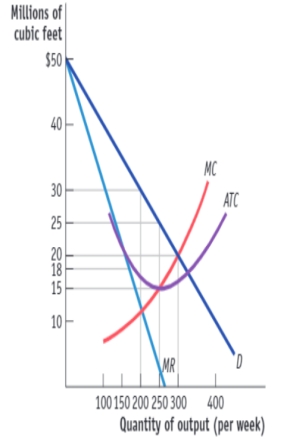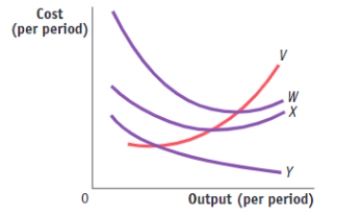A) prices will fall in the short run, and new firms will enter the market in the long run.
B) prices will rise in the short run, and new firms will enter the market in the long run.
C) prices will fall in the short run, and firms will leave the market in the long run.
D) prices will rise in the short run, and firms will leave the market in the long run.
Correct Answer

verified
Correct Answer
verified
Essay
What is the difference between explicit financial costs and implicit opportunity costs?
Correct Answer

verified
Correct Answer
verified
Multiple Choice
Luana gives up a salary of $80,000 per year to start her company. She invests $50,000 of her savings in her company, savings that had been earning her $4,000 per year in interest. During Luana's first year in business, total revenue is $300,000, and her explicit financial costs are $225,000. What is Luana's accounting profit from her first year in business?
A) -$59.000
B) -$9,000
C) $71,000
D) $75,000
Correct Answer

verified
Correct Answer
verified
Multiple Choice
If a product's usefulness increases with the number of users:
A) it is characterized by network externalities.
B) it is a natural monopoly.
C) it is a consortium enterprise.
D) the firm that produces it has an exclusive rights franchise.
Correct Answer

verified
Correct Answer
verified
Essay
Hua Xing forgoes a job with an annual salary of $80,000 to start her own interior design company. She invests $30,000 of her own savings in the company, which means forgoing the $3,000 per year that she has been earning on those savings. During her first year in business, Hua Xing's firm collects revenue of $250,000 and pays out $160,000 in expenses. What is Hua Xing's economic profit or loss situation at the end of her first year in business? Provide the specific amount of economic profit or loss, and explain how you arrived at that conclusion.
Correct Answer

verified
Correct Answer
verified
Multiple Choice
Alana's Confectionary is located in the East Side Village. When the market price of iced brownies is $5, the profit-maximizing output level is 150 brownies. Her average cost is $4, and her variable cost per unit is $3. Alana's marginal cost is _____, and her short-run profits are _____.
A) $5; $150
B) $5; $300
C) $1; $150
D) $1; $300
Correct Answer

verified
Correct Answer
verified
Essay
Explain the difference between accounting profit and economic profit. Why do economists prefer to use economic profit when analyzing the profitability of firms?
Correct Answer

verified
Correct Answer
verified
Multiple Choice
(Figure: Profit Maximization for SoCalGas) Use Figure: Profit Maximization for SoCalGas. SoCalGas's unit profit is:

A) $5.
B) $12.
C) $15.
D) $20.
Correct Answer

verified
Correct Answer
verified
Multiple Choice
When sellers exit a market in which the average seller has losses, what results?
A) The sellers that exit avoid the losses that the remaining market sellers continue to suffer.
B) The losses shrink or disappear as the market demand is spread over a smaller number of sellers.
C) The market demand shrinks as consumers avoid struggling sellers.
D) The remaining sellers have higher demand but also face cost curves that shift upward.
Correct Answer

verified
Correct Answer
verified
Multiple Choice
(Figure: The Cost Curves for Charlie's Cookie Confections) Use Figure: The Cost Curves for Charlie's Cookie Confections. The curve labeled X represents the firm's _____ cost curve.

A) marginal
B) average
C) fixed
D) variable
Correct Answer

verified
Correct Answer
verified
Multiple Choice
Ever since Giselle's company developed its new product ten years ago, Giselle has managed its production with little turnover in workers. During that time, the company's average cost has fallen by 30%, due to the refinement of its production methods, thereby achieving greater efficiency. Other rival companies have not achieved such low costs. The cost advantage that Giselle's company now has over rivals is referred to as _____ achieved through _____.
A) marginal cost reduction; long-term production
B) a key input price reduction; unique cost advantages
C) a unique cost advantage; learning by doing
D) mass production; key input price reduction
Correct Answer

verified
Correct Answer
verified
Multiple Choice
A company's profit margin is calculated as:
A) price minus total cost.
B) average revenue minus average cost.
C) price minus average direct financial costs.
D) average revenue minus total cost.
Correct Answer

verified
Correct Answer
verified
Multiple Choice
Because _____ profit is calculated based on _____ costs, it allows firm owners to make better decisions about _____.
A) economic; total; entering and exiting a market
B) accounting; total; increasing or decreasing output
C) economic; implicit opportunity; increasing or decreasing output
D) accounting; implicit opportunity; entering and exiting a market
Correct Answer

verified
Correct Answer
verified
Multiple Choice
Adhika is deciding whether to open a company to produce step stools. He should start the company if he expects that:
A) the number of step stool manufacturers will soon decrease.
B) the average cost curve will shift downward.
C) his price will exceed his average cost.
D) his marginal revenue will be below his average cost.
Correct Answer

verified
Correct Answer
verified
Multiple Choice
Candice's stand-up paddleboard company will earn profits producing and selling at any output level where the company's:
A) marginal cost curve is above its demand curve.
B) average cost curve is above its marginal revenue curve.
C) demand curve is above its average cost curve.
D) marginal revenue curve is below its average cost curve.
Correct Answer

verified
Correct Answer
verified
Multiple Choice
Super Snackin Services is in long-run equilibrium, and then there is an increase in the market demand for snacks. One expects that:
A) in the long run, new firms will enter the market.
B) there will be a short-run increase in the number of firms, but in the long run, the number of firms will return to the original level.
C) firms will leave the market in the long run.
D) firms will shut down, but they will not leave the industry in the long run.
Correct Answer

verified
Correct Answer
verified
Multiple Choice
How does a business owner know if it is financially worthwhile to open a business?
A) The implicit opportunity costs are less than revenue.
B) There are no implicit opportunity costs.
C) The business earns accounting profits.
D) The business earns economic profits.
Correct Answer

verified
Correct Answer
verified
Multiple Choice
Strategies used by entrepreneurs to overcome barriers to entry do NOT include:
A) finding ways to reduce costs.
B) using regulatory strategies to the entrepreneur's advantage.
C) duplicating the product of the industry leader.
D) combatting customer lock-in.
Correct Answer

verified
Correct Answer
verified
Multiple Choice
Amal gives up a salary of $80,000 per year to start his company. He invests $50,000 of his savings in his company, savings that had been earning him $4,000 per year in interest. During Amal's first year in business, total revenue is $300,000, and his explicit financial costs are $225,000. What is Amal's economic profit from his first year in business?
A) -$59.000
B) -$9,000
C) $71,000
D) $75,000
Correct Answer

verified
Correct Answer
verified
Multiple Choice
A company produces a particular cell phone that requires accessories (such as chargers, cases, and ear plugs) that are specific to that phone and cannot be used with phones manufactured by other companies. The company that produces this cell phone is using what strategy to create a barrier to entry?
A) Creating cost advantages.
B) Controlling the markets for key inputs needed by all firms in the product market.
C) Intimidating rivals.
D) Increasing switching costs to ensure demand for its product.
Correct Answer

verified
Correct Answer
verified
Showing 61 - 80 of 217
Related Exams